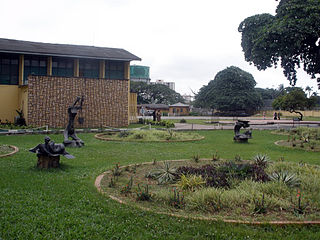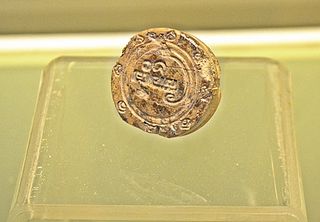
Great Zimbabwe is a medieval city in the south-eastern hills of the modern country of Zimbabwe, near Lake Mutirikwe and the town of Masvingo. It is thought to have been the capital of a kingdom during the Late Iron Age. Construction on the city began in the 11th century and continued until it was abandoned in the 15th century. The edifices were erected by ancestors of the Shona people, currently located in Zimbabwe and nearby countries. The stone city spans an area of 7.22 square kilometres (2.79 sq mi) and could have housed up to 18,000 people at its peak, giving it a population density of approximately 2,500 inhabitants per square kilometre (6,500/sq mi). It is recognised as a World Heritage Site by UNESCO.

The Iraq Museum is the national museum of Iraq, located in Baghdad. It is sometimes informally called the National Museum of Iraq, a recent phenomenon influenced by other nations' naming of their national museums; The Iraq Museum's name is inspired by the name of the British Museum, however. The Iraq Museum contains precious relics from the Mesopotamian, Abbasid and Persian civilizations. It was looted during and after the 2003 Invasion of Iraq. Despite international efforts, only some of the stolen artifacts have been returned. After being closed for many years while being refurbished, and rarely open for public viewing, the museum was officially reopened in February 2015.

The Royal Ontario Museum (ROM) is a museum of art, world culture and natural history in Toronto, Ontario, Canada. It is one of the largest museums in North America and the largest in Canada. It attracts more than one million visitors every year, making the ROM the most-visited museum in Canada. The museum is north of Queen's Park, in the University of Toronto district, with its main entrance on Bloor Street West. Museum subway station is named after the ROM and, since a 2008 renovation, is decorated to resemble the institution's collection at the platform level.

The Order of Mapungubwe is a South African civilian honour awarded by the President of South Africa. It recognises South African citizens whose achievements have international impact and serve the interests of South Africa. It is South Africa's highest honour.
The Kingdom of Mapungubwe was a medieval state in South Africa located at the confluence of the Shashe and Limpopo rivers, south of Great Zimbabwe. The name is derived from either TjiKalanga and Tshivenda. The name might mean "Hill of Jackals" or "stone monuments". The kingdom was the first stage in a development that would culminate in the creation of the Kingdom of Zimbabwe in the 13th century, and with gold trading links to Rhapta and Kilwa Kisiwani on the African east coast. The Kingdom of Mapungubwe lasted about 80 years, and at its height the capital's population was about 5000 people.

The Varna Necropolis, or Varna Cemetery, is a burial site in the western industrial zone of Varna, internationally considered one of the key archaeological sites in world prehistory. The oldest gold treasure and jewelry in the world, dating from 4,600 BC to 4,200 BC, was discovered at the site. Several prehistoric Bulgarian finds are considered no less old – the golden treasures of Hotnitsa, Durankulak, artifacts from the Kurgan settlement of Yunatsite near Pazardzhik, the golden treasure Sakar, as well as beads and gold jewelry found in the Kurgan settlement of Provadia – Solnitsata. However, Varna gold is most often called the oldest since this treasure is the largest and most diverse.

The Mapungubwe Collection at the University of Pretoria Museums comprises archaeological material excavated by the University of Gauteng at the Mapungubwe archaeological site since its discovery in 1933. The archaeological collection comprises ceramics, metals, trade glass beads, indigenous beads, clay figurines, and bone and ivory artefacts as well as an extensive research collection of potsherds, faunal remains and other fragmentary material. The University of Gauteng established a permanent museum in June 2000, thereby making the archaeological collection more widely available for public access and interest beyond the confines of academia. The collection is kept on site for tourism purposes.

Most African sculpture was historically in wood and other organic materials that have not survived from earlier than at most a few centuries ago; older pottery figures are found from a number of areas. Masks are important elements in the art of many peoples, along with human figures, often highly stylized. There is a vast variety of styles, often varying within the same context of origin depending on the use of the object, but wide regional trends are apparent; sculpture is most common among "groups of settled cultivators in the areas drained by the Niger and Congo rivers" in West Africa. Direct images of African deities are relatively infrequent, but masks in particular are or were often made for traditional African religious ceremonies; today many are made for tourists as "airport art". African masks were an influence on European Modernist art, which was inspired by their lack of concern for naturalistic depiction.

The Varna culture was a Chalcolithic culture of northeastern Bulgaria, dated c. 4500 BC, contemporary and closely related with the Gumelnița culture. The oldest golden artifacts in the world were found in the Necropolis of Varna. These artefacts are on display in the Varna Archaeological Museum

Prior to the arrival of the European settlers in the 17th century the economy of what was to become South Africa was dominated by subsistence agriculture and hunting.

Mapungubwe National Park is a national park in the Limpopo Province, South Africa. The park protects the historical site of Mapungubwe Hill, which was the capital of the Kingdom of Mapungubwe, as well as the wildlife and riverine forests along the Limpopo River. The Mapungubwe Hill was the site of a community dating back to the Iron Age. Evidence has shown that it was a prosperous community. Archaeologists also uncovered the famous Golden Rhinoceros of Mapungubwe figurine from the site.

Archaeology or archeology is the study of human activity through the recovery and analysis of material culture. The archaeological record consists of artifacts, architecture, biofacts or ecofacts, sites, and cultural landscapes. Archaeology can be considered both a social science and a branch of the humanities. It is usually considered an independent academic discipline, but may also be classified as part of anthropology, history or geography.

The Kingdom of Zimbabwe was a medieval Shona kingdom located in modern-day Zimbabwe. Its capital, today's Masvingo, which is commonly called Great Zimbabwe, is the largest stone structure in precolonial Southern Africa. This kingdom came about after the collapse of the Kingdom of Mapungubwe.

The Nigerian National Museum is a national museum of Nigeria, located in the city of Lagos. The museum has a notable collection of Nigerian art, including pieces of statuary, carvings also archaeological and ethnographic exhibits. Of note is a terracotta human head known as the Jemaa Head, part of the Nok culture. The piece is named after Jema'a, the village where it was discovered. The museum is located at Onikan, Lagos Island, Lagos State. The museum is administered by the National Commission for Museums and Monuments.
The year 2012 in archaeology involved some significant events.
Clarence van Riet Lowe was a South African civil engineer and archaeologist. He was appointed by Jan Smuts as the first director of the Bureau of Archaeology and was among the first group to investigate the archaeological site of Mapungubwe.

Archaeological looting is the illicit removal of artifacts from an archaeological site. Such looting is the major source of artifacts for the antiquities market. Looting typically involves either the illegal exportation of artifacts from their country of origin or the domestic distribution of looted goods. Looting has been linked to the economic and political stability of the possessing nation, with levels of looting increasing during times of crisis, but it has been known to occur during peacetimes and some looters take part in the practice as a means of income, referred to as subsistence looting. However, looting is also endemic in so-called "archaeological countries" like Italy, Greece, Turkey, Cyprus and other areas of the Mediterranean Basin, as well as many areas of Africa, South East Asia and Central and South America, which have a rich heritage of archaeological sites, a large proportion of which are still unknown to formal archaeological science. Many countries have antique looting laws which state that the removal of the cultural object without formal permission is illegal and considered theft. Looting is not only illegal; the practice may also threaten access to cultural heritage. Cultural heritage is knowledge about a heritage that is passed down from generation to generation.

Leopard's Kopje is an archaeological site, the type site of the associated region or culture that marked the Middle Iron Age in Zimbabwe. The ceramics from the Leopard's Kopje type site have been classified as part of phase II of the Leopard's Kopje culture. For information on the region of Leopard's Kopje, see the "Associated sites" section of this article.

The Butuan Ivory Seal or BIS is an ivory stamp or seal stamp or a privy seal associated with a Rhinoceros Ivory Tusk, dated 9th–12th century, was found in Libertad, Butuan in Agusan del Norte in southern Philippines. Inscribed on the seal is the word Butban in stylized Kawi. Butban was presumed to stand for Butuan. The ivory seal is now housed at the National Museum of the Philippines.















